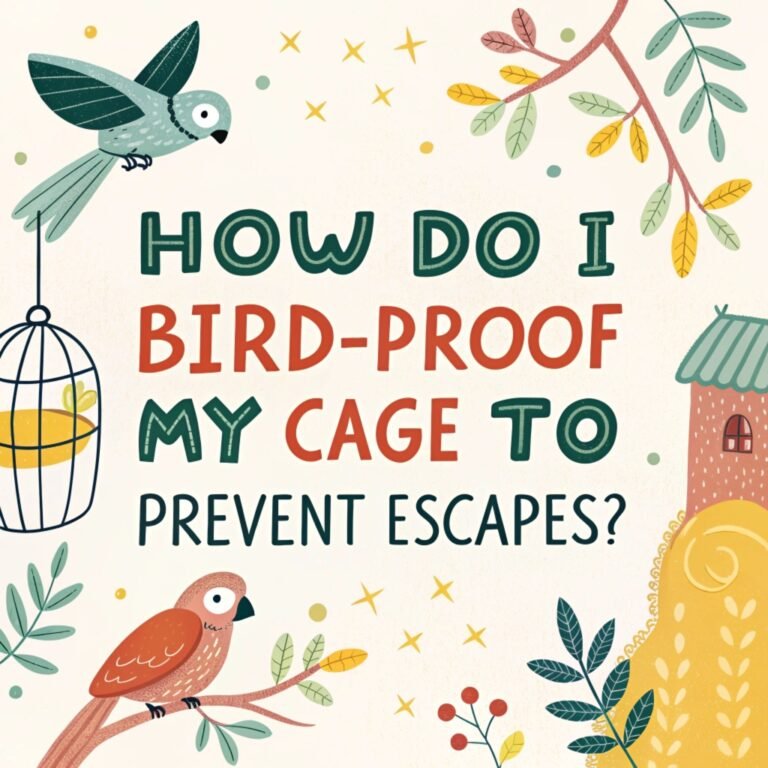Should I Get a Sleep Cage for My Bird? A Comprehensive Guide to Improving Your Feathered Friend’s Rest
This is where the concept of a sleep cage comes into play. A sleep cage is a specialized, smaller cage designed to provide your bird with a quiet, dark, and peaceful environment for rest.
However, in our modern homes filled with artificial light and constant activity, replicating these conditions can be challenging.
In the wild, birds follow natural light cycles, roosting as the sun sets and waking with the dawn.

Key Takeaways
Before we dive into the details, here are the essential points to remember about sleep cages for birds:
- Sleep cages are smaller, secondary cages designed specifically for nighttime rest.
- Birds typically need 10-12 hours of uninterrupted sleep each night for optimal health.
- A sleep cage can help minimize disturbances and create an ideal sleeping environment.
- Benefits include improved sleep quality, reduced stress, and better hormonal balance.
- Potential drawbacks involve additional cost, space requirements, and an adjustment period for your bird.
- Not all birds necessarily need a sleep cage, especially if they sleep well in their main cage.
- Alternatives to sleep cages include cage covers and modifying the bird’s environment.
- The decision to use a sleep cage should be based on your bird’s individual needs and your home environment.
- Proper setup and consistent routine are crucial for the success of using a sleep cage.
- Observing your bird’s behavior can help determine if a sleep cage would be beneficial.
Now, let’s explore each aspect of sleep cages in more detail to help you decide if this is the right choice for your avian companion.
What Is a Sleep Cage and How Does It Work?
A sleep cage is a specialized, secondary cage designed to provide birds with an optimal environment for rest.
Unlike the primary cage, which is typically larger and equipped with various toys, perches, and feeding stations, a sleep cage is intentionally simpler and more focused on creating a peaceful sleeping space.
The concept behind a sleep cage is to mimic the natural sleeping conditions that birds would experience in the wild.
In their natural habitats, birds often seek out quiet, dark places to roost for the night, away from potential predators and disturbances. A sleep cage aims to recreate this environment within a domestic setting.
Sleep cages are usually smaller than a bird’s main living space, providing just enough room for comfortable rest without excess space for activity.
They are typically placed in a quiet, dark room or area of the house, away from the hustle and bustle of daily life. This setup helps to minimize external stimuli that might disrupt your bird’s sleep.
The functionality of a sleep cage revolves around its ability to create a consistent and calming nighttime routine for your feathered friend.
By moving your bird to this dedicated sleeping area each night, you establish a clear signal that it’s time to rest.
This can be particularly beneficial for birds living in homes where the main cage is located in a busy or well-lit area.
Why Is Sleep Important for Birds?

Just like humans and other animals, birds require adequate sleep to maintain their physical and mental health.
In fact, most birds need between 10 to 12 hours of uninterrupted sleep each night to function optimally.
This substantial sleep requirement underscores the importance of providing a suitable sleeping environment for your avian companion.
Sleep plays a crucial role in various aspects of a bird’s well-being:
- Physical Health: During sleep, birds’ bodies undergo essential repair and regeneration processes. Adequate rest supports their immune system, helping them fight off diseases and maintain overall health.
- Mental Well-being: Proper sleep is vital for a bird’s cognitive functions and emotional stability. Well-rested birds are typically more alert, responsive, and better able to learn and interact with their environment.
- Behavior Regulation: Lack of sleep can lead to irritability and aggressive behavior in birds. Ensuring your feathered friend gets enough rest can help maintain a calm and friendly demeanor.
- Hormonal Balance: Sleep plays a significant role in regulating a bird’s hormonal cycles. Disrupted sleep patterns can lead to hormonal imbalances, potentially affecting breeding behaviors and overall health.
- Stress Reduction: Adequate sleep helps birds manage stress more effectively. A well-rested bird is better equipped to handle changes in its environment and interactions with humans and other animals.
In their natural habitats, birds typically follow the sun’s natural cycle, sleeping when it’s dark and waking with the dawn. However, in a domestic environment, artificial lighting and household activities can disrupt this natural rhythm.
This is where the concept of a sleep cage becomes particularly relevant, as it aims to recreate a more natural sleeping environment for your bird.
Benefits of Using a Sleep Cage
Incorporating a sleep cage into your bird’s routine can offer numerous advantages for their overall well-being. Let’s explore these benefits in detail:
- Minimizes Disturbances
A sleep cage placed in a quiet, secluded area of your home can significantly reduce nighttime disturbances for your bird. This setup shields them from common household noises such as television sounds, conversations, or the activities of nocturnal pets. By creating this peaceful environment, you’re ensuring that your bird can enjoy uninterrupted rest, which is crucial for their health and well-being. - Encourages Better Sleep Quality
The controlled environment of a sleep cage helps to mimic the natural sleeping conditions birds experience in the wild. With reduced light and noise, your bird is more likely to enter into deeper, more restful sleep cycles. This improved sleep quality can lead to a happier, healthier bird during waking hours. - Reduces Stress
Birds are highly sensitive to their surroundings, and a chaotic or unpredictable environment can cause significant stress. A dedicated sleep cage provides a consistent, safe space for your bird to retreat to each night. This routine can help lower stress levels, leading to improved overall health and behavior. - Helps with Hormonal Behavior
Some birds become hormonal when exposed to extended daylight hours or cozy nesting spots in their main cage. A separate sleep cage can help regulate their hormonal cycles by providing a consistent day-night rhythm. This can be particularly beneficial in preventing unwanted breeding behaviors or aggression related to hormonal changes. - Promotes Routine
Establishing a bedtime routine with a sleep cage can have positive effects on your bird’s behavior and well-being. A consistent schedule helps your bird understand when it’s time to rest, potentially reducing anxiety and improving their overall sense of security. - Enhances Daytime Activity
When birds get adequate, quality sleep, they’re more likely to be active and engaged during the day. This can lead to increased interaction with their environment, toys, and human companions, promoting better physical and mental stimulation. - Supports Health and Longevity
By ensuring your bird gets the rest it needs, you’re supporting its long-term health and potentially increasing its lifespan. Well-rested birds typically have stronger immune systems and are better equipped to handle daily stressors. - Customizable Environment
A sleep cage allows you to tailor the sleeping environment specifically to your bird’s needs. You can control factors like darkness levels, temperature, and humidity more easily in a dedicated sleep space. - Reduces Night Frights
Some birds are prone to night frights, where they become startled and may injure themselves flapping around their cage. A smaller, more secure sleep cage can help minimize the risk of injury during these episodes. - Facilitates Medical Care
If your bird ever needs special care or monitoring, a sleep cage can provide a controlled environment for administering medication or observing your bird’s condition without the distractions of toys or a larger space.
Potential Drawbacks of Sleep Cages

While sleep cages offer numerous benefits, it’s important to consider potential drawbacks to make an informed decision:
- Adjustment Period
Introducing a sleep cage requires a transition period for your bird. Some birds may take time to adapt to the new sleeping arrangement, potentially leading to temporary stress or disrupted sleep patterns. It’s crucial to be patient and consistent during this adjustment phase. - Additional Cost
Purchasing a separate sleep cage represents an extra expense for bird owners. Quality cages can be costly, and you’ll need to factor in the price of any additional accessories like perches or covers. - Space Requirements
A sleep cage necessitates additional space in your home. This can be challenging for those living in smaller apartments or houses with limited room. You’ll need to find a quiet, dark area to place the sleep cage, which might not be feasible for everyone. - Increased Cleaning and Maintenance
Having an additional cage means more cleaning and upkeep. You’ll need to regularly clean and disinfect both the main cage and the sleep cage, which can be time-consuming. - Potential for Stress
While sleep cages aim to reduce stress, the process of moving between cages can be stressful for some birds. Birds that are particularly anxious or attached to their main cage might find the nightly transition unsettling. - Risk of Overuse
There’s a potential for owners to rely too heavily on the sleep cage, keeping their bird confined for longer than necessary. This could lead to reduced exercise and socialization time if not managed properly. - Not Always Necessary
For birds that sleep well in their main cage without disturbances, a sleep cage might be an unnecessary addition. It’s important to assess your bird’s individual needs before investing in a sleep cage. - Disruption of Bonding Time
Moving your bird to a separate cage at night might reduce evening bonding time with your pet, especially if you’re typically home in the evenings. - Potential for Territorial Behavior
Some birds might become territorial over their sleep cage, leading to aggressive behavior when it’s time to return to their main cage. - Temperature Considerations
If the sleep cage is placed in a different room, you’ll need to ensure that the temperature and airflow are suitable for your bird, which might require additional heating or cooling solutions.
How to Choose the Right Sleep Cage
Selecting the appropriate sleep cage for your bird is crucial for ensuring their comfort and safety. Here are key factors to consider:
- Size Matters
The sleep cage should be large enough for your bird to stand comfortably and turn around, but not so spacious that it encourages activity. A good rule of thumb is to choose a cage that’s about half the size of your bird’s main living space. For example:
- Small parrots like budgies or lovebirds need compact cages around 18″ x 18″ x 18″.
- Medium-sized birds like conures or cockatiels might require cages about 20″ x 20″ x 20″.
- Larger parrots like African Greys or Amazons may need sleep cages around 24″ x 24″ x 24″.
- Material and Construction
Opt for sturdy, bird-safe materials like stainless steel or powder-coated metal. Ensure the cage has:
- Smooth edges to prevent injury
- Secure locks to keep your bird safely inside
- Non-toxic finishes that won’t harm your bird if chewed
- Bar Spacing
The spacing between bars should be appropriate for your bird’s size to prevent escape or injury:
- Small birds: 3/8″ to 1/2″ bar spacing
- Medium birds: 1/2″ to 5/8″ bar spacing
- Large birds: 3/4″ to 1″ bar spacing
- Simplicity is Key
Keep the sleep cage simple and uncluttered. Avoid placing toys or mirrors that could distract your bird from sleeping. Include only:
- One or two comfortable perches
- A simple food and water dish (if recommended by your vet)
- Portability
A lightweight and portable design makes it easier to move the sleep cage to different rooms if needed. Consider cages with built-in handles or wheels for easy transportation. - Ease of Cleaning
Choose a cage with features that make cleaning quick and efficient:
- Removable bottom tray
- Smooth surfaces that are easy to wipe down
- Minimal crevices where debris can accumulate
- Ventilation
Ensure the cage has adequate airflow to maintain a comfortable sleeping environment. Look for cages with multiple sides of bars rather than solid panels. - Security Features
Consider cages with additional security measures:
- Double locks on doors
- Escape-proof food and water dish attachments
- Secure perch attachments
- Compatibility with Covers
If you plan to use a cage cover, ensure the cage design is compatible with standard covers or comes with a custom-fit option. - Brand Reputation
Choose cages from reputable manufacturers known for producing quality bird products. Research customer reviews and seek recommendations from avian veterinarians or experienced bird owners.
Setting Up Your Bird’s Sleep Cage
Creating the ideal sleep environment for your bird involves more than just selecting the right cage. Here’s a step-by-step guide to setting up your bird’s sleep cage:
- Choose the Right Location
Place the sleep cage in a quiet, dark room away from household activity. Ideal locations include:
- A spare bedroom
- A secluded corner of your living space
- A dedicated bird room, if available
- Control Light Exposure
Use blackout curtains or shades to block out external light sources. This helps mimic natural darkness and promotes better sleep. - Manage Temperature
Ensure the room temperature is consistent and comfortable for your bird species. Most birds prefer temperatures between 65°F to 80°F (18°C to 27°C). - Reduce Noise
Minimize noise disturbances by:
- Placing the cage away from windows or exterior walls
- Using white noise machines or soft nature sounds to mask sudden noises
- Informing household members about the importance of quiet during your bird’s sleep hours
- Install Appropriate Perches
Add one or two comfortable perches at different heights. Choose perches that are:
- Appropriate for your bird’s foot size
- Made of natural, non-toxic materials
- Positioned to allow your bird to feel secure
- Provide Minimal Accessories
Keep the sleep cage simple:
Remember, patience is key when introducing a new sleep routine. It may take several days or even weeks for your bird to fully adjust to the sleep cage. Consistency and a calm approach will help make the transition smoother for your feathered friend.
Signs That Your Bird Might Need a Sleep Cage
Not all birds require a separate sleeping area, but certain behaviors and circumstances might indicate that your feathered friend could benefit from a sleep cage. Here are some signs to watch for:
- Daytime Fatigue
If your bird appears unusually tired or lethargic during the day, it might not be getting enough quality sleep. Look for signs such as:
- Frequent napping during daylight hours
- Decreased activity levels or interest in toys
- Droopy or half-closed eyes when they should be alert
- Behavioral Issues
Lack of proper sleep can lead to various behavioral problems. Watch for:
- Increased irritability or aggression
- Excessive screaming or vocalization
- Feather plucking or other self-destructive behaviors
- Restlessness at Night
If your bird seems unable to settle down in the evening, it might be struggling with its current sleeping environment. Signs include:
- Constant movement or fidgeting on perches
- Frequent vocalizations after dark
- Night frights or sudden episodes of panic
- Environmental Factors
Consider your bird’s current living situation:
- Is the main cage located in a noisy or brightly lit area?
- Are there frequent disturbances during nighttime hours?
- Does your household have irregular schedules that might disrupt your bird’s sleep?
Remember, every bird is unique, and what works for one might not be suitable for another. Always observe your bird’s behavior closely and consult with an avian veterinarian if you have concerns about their sleep patterns or overall health.
FAQs
Do all birds need a sleep cage?
No, not all birds need a separate sleep cage. The necessity depends on factors such as the bird’s species, individual temperament, and current living environment. Some birds sleep perfectly well in their main cage, especially if it’s already in a quiet, dark location.
How big should a sleep cage be?
The size of the sleep cage should be comfortable but not spacious. A good rule of thumb is to choose a cage about half the size of your bird’s main living space. It should allow your bird to stand, turn around, and stretch its wings comfortably.
Should I cover my bird’s main cage instead of using a sleep cage?
Covering the main cage can be an effective alternative if it successfully blocks out light and reduces noise without causing stress to your bird. However, ensure the cover is breathable and allows for proper ventilation.
Can I use the same perch in both cages?
Yes, using similar perches can help your bird feel more comfortable transitioning between cages. Familiar items can reduce stress associated with the new sleeping environment.
How long does it take for birds to adjust to a sleep cage?
The adjustment period varies depending on the individual bird’s personality and temperament. Some birds may adapt within a few days, while others might take several weeks. Consistency and patience are key during this transition.
What time should I put my bird in the sleep cage?
Aim to establish a consistent bedtime routine. Most birds do well with 10-12 hours of sleep, so adjust the bedtime based on when you typically uncover the cage in the morning. For example, if you uncover at 7 AM, consider a bedtime between 7-9 PM.
Can multiple birds share a sleep cage?
It’s generally not recommended for multiple birds to share a sleep cage, even if they’re compatible during the day. Each bird should have its own sleeping space to prevent potential conflicts and ensure undisturbed rest.

Hello, I’m Amelia White, the founder of birdsfanatic.com. As a lifelong bird enthusiast and spiritual seeker, I’ve always been fascinated by the mystical connections between birds and the human experience. On this site, I share my knowledge and insights into the symbolic meanings and spiritual significance of various bird species, exploring their roles in mythology, folklore, and cultural traditions. Join me on this journey into the world of birds, where we’ll discover the hidden wisdom and guidance that these magnificent creatures have to offer.







